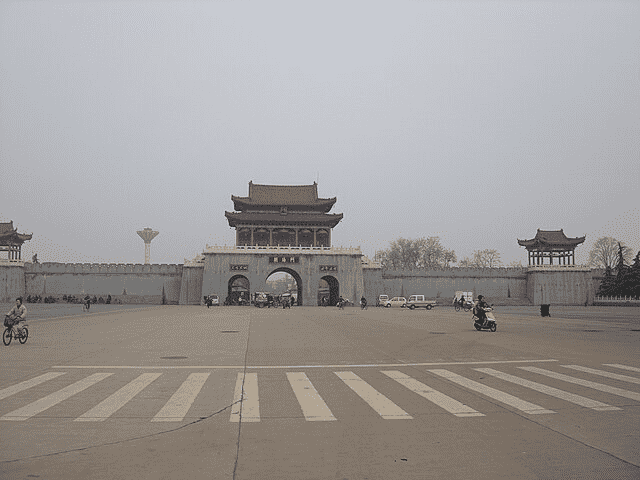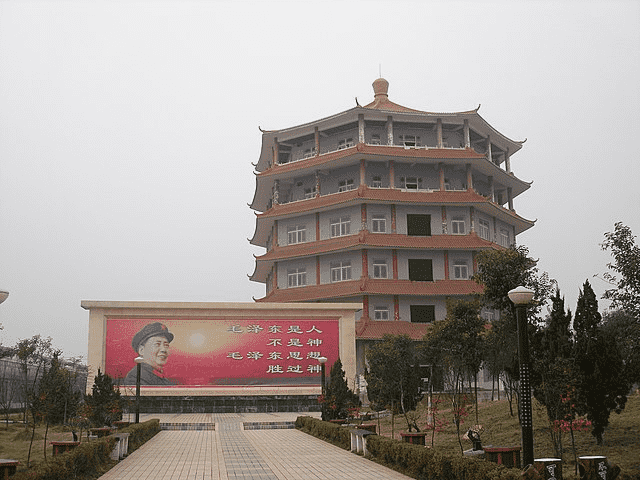In the small Chinese village of Nanjie, residents live in a time capsule of the Cultural Revolution.
The East is Red Square. Nicolas Oddo. CC BY-ND 2.0
While China’s Cultural Revolution officially ended in 1976 with the death of Chairman Mao Zedong, the more than 3,000 residents of Nanjie, in Central China’s Henan province, continue to live by the principles of Maoism. While the village is reportedly one of China’s wealthiest, having grown its economy by nearly 2,000 fold in just ten years, workers in the village’s factory have agreed to accept a monthly salary of only about $400. In the 1980s, when the rest of China was opening up to the capitalist market, Nanjie chose to revert to the system of collective ownership taught by Mao.
Nanjie Commune Gate. Gary Lee Todd. CC0 1.0
Nanjie is small, comprising about two dozen factories and several main streets. Mao Zedong’s face is displayed all over the village in the form of billboards, posters and framed portraits. A giant statue of the Cultural Revolution’s late leader can be found in the middle of the town’s main square, the “East is Red” Square. On each side of the looming statue are portraits of four other famous communists: Karl Marx, Friedrich Engels, Vladimir Lenin and Joseph Stalin. North of the square stands the traditional-style Chaoyang Gate, decorated with a portrait of Sun Yat-sen.
In the square, a speech from Mao is played on a perpetual loop. New party members take their oaths in the square. On National Day, all couples in the village get married in a single collective ceremony and bow to the statue of Chairman Mao. As a wedding gift, they receive copies of Mao’s “Little Red Book.”
Nanjie Commune. Gary Lee Todd. CC0 1.0
The village's economy is dominated by collective ownership and management of all production and rationing supplies like coal, cooking oil, candy and even cigarettes. Residents are awoken each morning by “Dongfang Hong” (“The East is Red”), the de facto anthem of the Cultural Revolution, playing over loudspeakers. While some residents have chosen to leave the village in pursuit of capitalist success, many prefer the commune lifestyle free from the stress of higher living costs and housing loans.
Exterior of Nanjie Commune Apartments. Gary Lee Todd. CC0
Interior of Nanjie Commune Apartment. Gary Lee Todd. CC0 1.0
Since the 90s, almost all village inhabitants have been living in collectively built apartments, with rent often funded by welfare. Every month, each resident receives vouchers of about $13 to cover the cost of food and groceries at the village’s commune-style supermarket. Locals also receive free healthcare and education.
Nanjie Commune Greenhouse. Gary Lee Todd. CC0
Nanjie even has a theme park dedicated to the history of the Chinese Communist Party, featuring re-creations of significant historical events and a $1.2 million greenhouse. The garden houses more than 500 flower species and 10,000 plants, as well as sculptures of animals like kangaroos and dinosaurs. Aside from the theme park and the greenhouse, the village also houses five parks, a zoo, a small artificial mountain set with bridges over a moat, a large swimming center and a grand mosque. While the village itself might be small, its historic, almost museum-like preservation, unique cultural heritage and the pride that locals take in their way of life make for a fascinating window into a bygone era.
GETTING THERE
Traveling to the collective is not difficult. From Zhengzhou, the capital of Henan province, buses (Y31; two hours) run south to Linying every hour between 6:40 am and 6:10 pm local time. From Linying it is a 1.2-mile walk south to Nanjie on the east side of the road. Taxi cabs are also available. Hotels are available in Nanjie and the surrounding areas.
Rebecca Pitcairn
Rebecca studies Italian Language and Literature, Classical Civilizations, and English Writing at the University of Pittsburgh. She hopes to one day attain a PhD in Classical Archeology. She is passionate about feminism and climate justice. She enjoys reading, playing the lyre, and longboarding in her free time.





